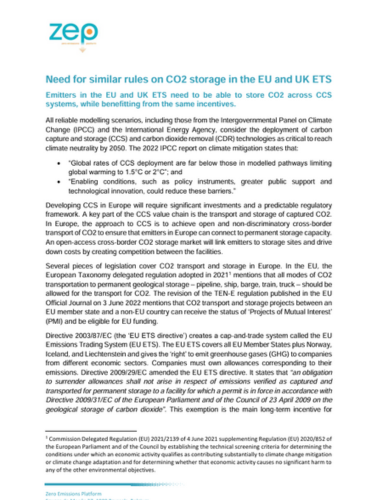Need for similar rules on CO2 storage in the EU and UK ETS
Approved by the AC71 on 15 June 2022, the Zero Emissions Platform (ZEP) set forth a paper on enabling emitters covered by the EU and UK ETS to store CO2 across CCS systems, while benefitting from the same incentives. It is understood that full linking between the two systems would take several years of negotiations. A solution for the acceptance of CO2 stored in the other system in the shorter term would build on agreements and sharing information on storage application documentation, permitting, monitoring, etc.
Need for similar rules on CO2 storage in the EU and UK ETS
All reliable modelling scenarios, including those from the Intergovernmental Panel on Climate Change (IPCC) and the International Energy Agency, consider the deployment of carbon capture and storage (CCS) and carbon dioxide removal (CDR) technologies as critical to reach climate neutrality by 2050. The 2022 IPCC report on climate mitigation states that:
- “Global rates of CCS deployment are far below those in modelled pathways limiting global warming to 1.5°C or 2°C”; and
- “Enabling conditions, such as policy instruments, greater public support, and technological innovation, could reduce these barriers.”
Developing CCS in Europe will require significant investments and a predictable regulatory framework. A key part of the CCS value chain is the transport and storage of captured CO2. In Europe, the approach to CCS is to achieve open and non-discriminatory cross-border transport of CO2 to ensure that emitters in Europe can connect to permanent storage capacity. An open-access cross-border CO2 storage market will link emitters to storage sites and drive down costs by creating competition between the facilities.
Several pieces of legislation cover CO2 transport and storage in Europe. In the EU, the European Taxonomy delegated regulation adopted in 2021 mentions that all modes of CO2 transportation to permanent geological storage – pipeline, ship, barge, train, truck – should be allowed for the transport of CO2. The revision of the TEN-E regulation published in the EU Official Journal on 3 June 2022 mentions that CO2 transport and storage projects between an EU member state and a non-EU country can receive the status of ‘Projects of Mutual Interest’ (PMI) and be eligible for EU funding.
Directive 2003/87/EC (the ‘EU ETS directive’) creates a cap-and-trade system called the EU Emissions Trading System (EU ETS). The EU ETS covers all EU Member States plus Norway, Iceland, and Liechtenstein, and gives the ‘right’ to emit greenhouse gases (GHG) to companies from different economic sectors. Companies must own allowances corresponding to their emissions. Directive 2009/29/EC amended the EU ETS directive. It states that “an obligation to surrender allowances shall not arise in respect of emissions verified as captured and transported for permanent storage to a facility for which a permit is in force in accordance with Directive 2009/31/EC of the European Parliament and of the Council of 23 April 2009 on the geological storage of carbon dioxide”. This exemption is the main long-term incentive for carbon capture and storage under the EU ETS, as emitters do not have to buy allowances if CO2 is captured and permanently stored.
In the UK, the EU ETS Directive was transposed through the Greenhouse Gas Emissions Trading Scheme Regulations 2012. A UK Emissions Trading Scheme (UK ETS) replaced the UK’s participation in the EU ETS as of 1 January 2021, following the UK’s withdrawal from the EU on 31 January 2020.
Challenge
UK emitters storing their CO2 in a UK site are exempted from the need to surrender allowances under the UK ETS. Emitters in the EU ETS storing their CO2 at a site located in the EU ETS are also exempted from surrendering allowances under the EU ETS. It is unclear, however, what type of rules apply when an emitter in one ETS stores CO2 in the other ETS, e.g., when industrial facilities located in the EU want to export their CO2 to the UK for permanent storage in the North Sea.
To create the best possible conditions for cross-border competition, an emitter should receive an exemption from the need to surrender allowances regardless of the ETS in which the CO2 is stored. Greater legal certainty would provide clear financial incentives to emitters and CO2 transporters and create a CO2 transport and storage network with larger economies of scale, lower costs, and enhanced innovation.
The key element to remove this uncertainty and enable an across-Europe competitive market for CO2 storage is to guarantee ‘high-quality storage of CO2’ between both systems. The UK and the EU should agree on the definition of ‘high-quality storage of CO2’ and the rules that underpin this definition. Following this agreement, the UK and EU legislation should be amended to introduce a provision recognising as equivalent relevant storage sites that fall under this definition.
Window of opportunity
The UK ETS Authority launched a consultation on the UK ETS on 25 March 2022. The consultation will run until 17 June 2022, ahead of a possible revision of the existing system.
The European Commission proposed a revision of the EU ETS directive on 14 July 2021. This proposal is a key element of the Fit for 55 package, a set of legislative proposals that aims to reduce net greenhouse gas emissions by at least 55% by 2030. Inter-institutional negotiations between the Council, the Parliament, and the Commission on the proposed revision are due to take place shortly.
The Zero Emissions Platform (ZEP) calls on the UK and the EU to take advantage of this opportunity and agree on rules defining ‘high-quality storage of CO2’ to create legal certainty for the European CCS value chain.
